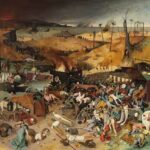![]()
In 1925, Florida passed a law requiring daily reading of the Bible in public schools. Forty-five thousand members of the Ku Klux Klan marched in Washington, D.C. In July, Tennessee public school teacher John Scopes was placed on trial and convicted for teaching Darwin’s theory of evolution. President Coolidge reduced the White House budget by replacing paper cups with glasses, reducing the number of towels in lavatories, and rationing food in the kitchen.
In the movies (silent of course), Charlie Chaplin starred in the hilarious comedy The Gold Rush. A key scene shows him as the starving central character meticulously preparing and then eating the sole of his shoe. The original Ben-Hur starred Ramon Novarro. The original Phantom of the Opera starred Lon Chaney. Top stars at the box office included Rudolph Valentino, Douglas Fairbanks, Mary Pickford, Charlie Chaplin, Harold Lloyd, Gloria Swanson, and Lillian Gish. Radio became the communications medium of choice for a huge number of Americans.
According to a Library of Congress estimate, the radio audience was 50 million strong, a large portion of the population at that time. The all-electric phonograph (as distinct from the windup or battery-run type) began to attract massive public attention, and the recording industry took off. Louis Armstrong and Duke Ellington made their first recordings, while Lawrence Welk formed a new band that played “society music.”
In the field of modern concert music of avant-garde persuasion, Edgar Varèse composed Intégrales, Henry Cowell The Banshee. Igor Stravinsky performed his Concerto for Piano and Winds (which premiered in France in 1924) with the Boston Symphony Orchestra. To an audience with eclectic tastes, George Gershwin presented his Concerto in F for Piano and Orchestra in New York.
The Metropolitan Museum of Art recorded the largest attendance in its history: over one million visitors. John D. Rockefeller endowed the institution that became the present-day medieval Cloisters in New York City. Landmarks in American literature: F. Scott Fitzgerald’s The Great Gatsby and Theodore Dreiser’s An American Tragedy. Sinclair Lewis won the Pulitzer Prize for literature with Arrowsmith. In professional athletics, Bill Tilden won his fifth straight tennis singles championship, and burlesque star Carrie Finnel attracted considerable attention from an enthusiastic audience by twirling tassels from her breasts and buttocks.
American patterns of courtship were changing, with the automobile beginning to replace the parlor as the venue of choice for romantic undertakings. Ever susceptible to fads, the public indulged in limerick contests, the collecting of baseball cards, the worship of athletic heroes, and marathons of various kinds, among them dancing, talking, and flagpole sitting. And of course musical theater flourished in its natural habitat, the borough of Manhattan of New York City, where Richard Rodgers and Lorenz Hart took a big step toward the stellar position they ultimately came to occupy.
The Birth and Early History of “Manhattan”
Rodgers and Hart wrote “Manhattan” in 1922 for a show called Winkle Town, which was never produced. Nevertheless, as it turned out, the song became a landmark in their fledgling career, setting the stage for their long and remarkable presence on the American musical scene. Three years later, when the song was included in the review “Garrick Gaieties,” its popularity was instantaneous. Rodgers has related his impression at the end of the first performance:
“I turned around to look at the audience; everyone was standing. Not standing to leave, just standing. Not just standing, either. Standing and clapping, cheering, yelling, stomping, waving and whistling. I turned back to the orchestra and had the boys strike up ‘Manhattan.’ The cast sang it. The musicians sang it. Even the audience sang it.”
Why this spontaneous reaction? I will try to answer that question in one way by considering an important aspect of the melody, its constituent figures, or motives, and by pointing out some of the ways in which Hart’s ingenious lyrics enhance them. At the same time this provides an opportunity to deal with some general aspects of the melodic details that are so important to any song and to the listener who wishes to delve below the surface.







